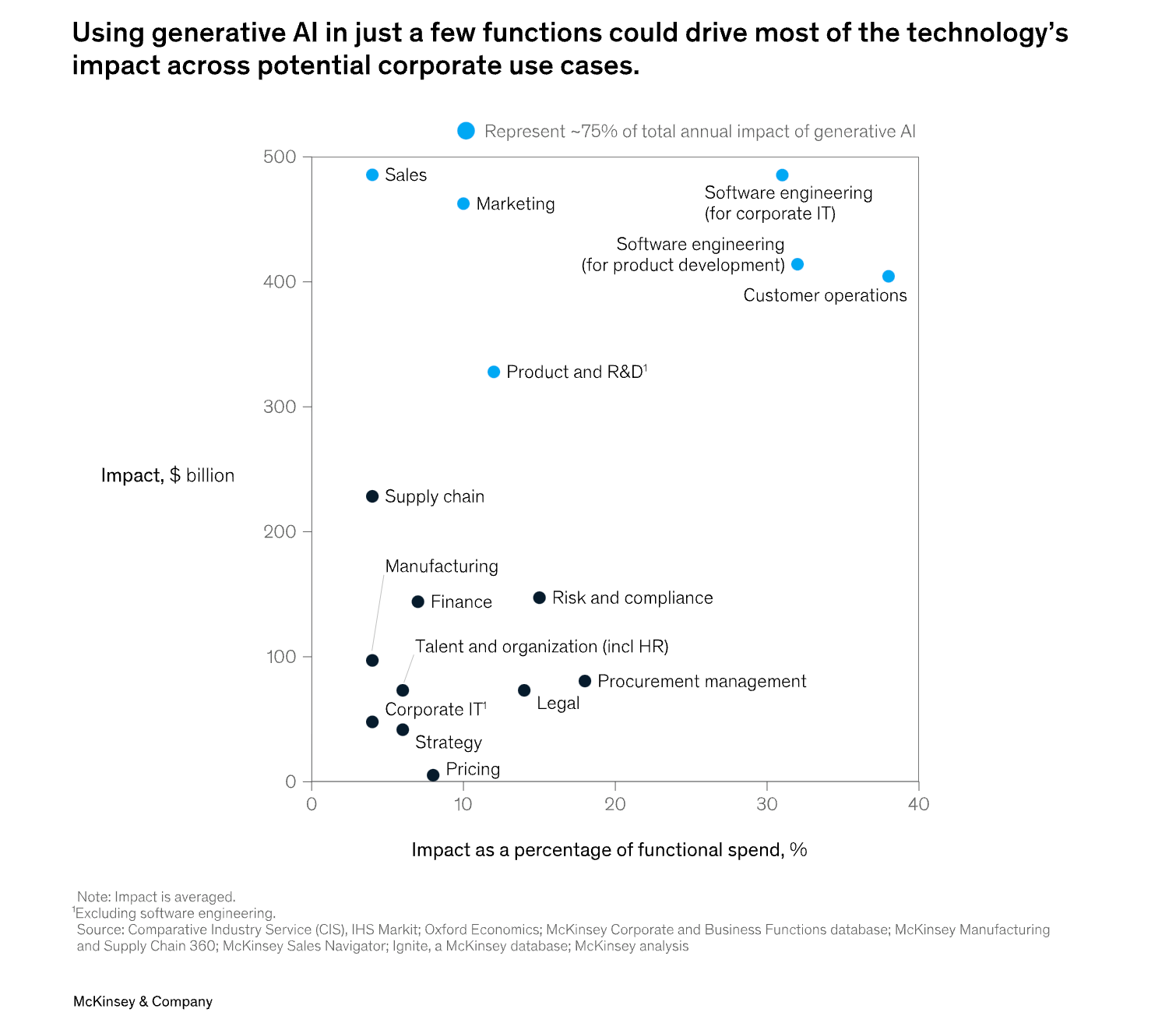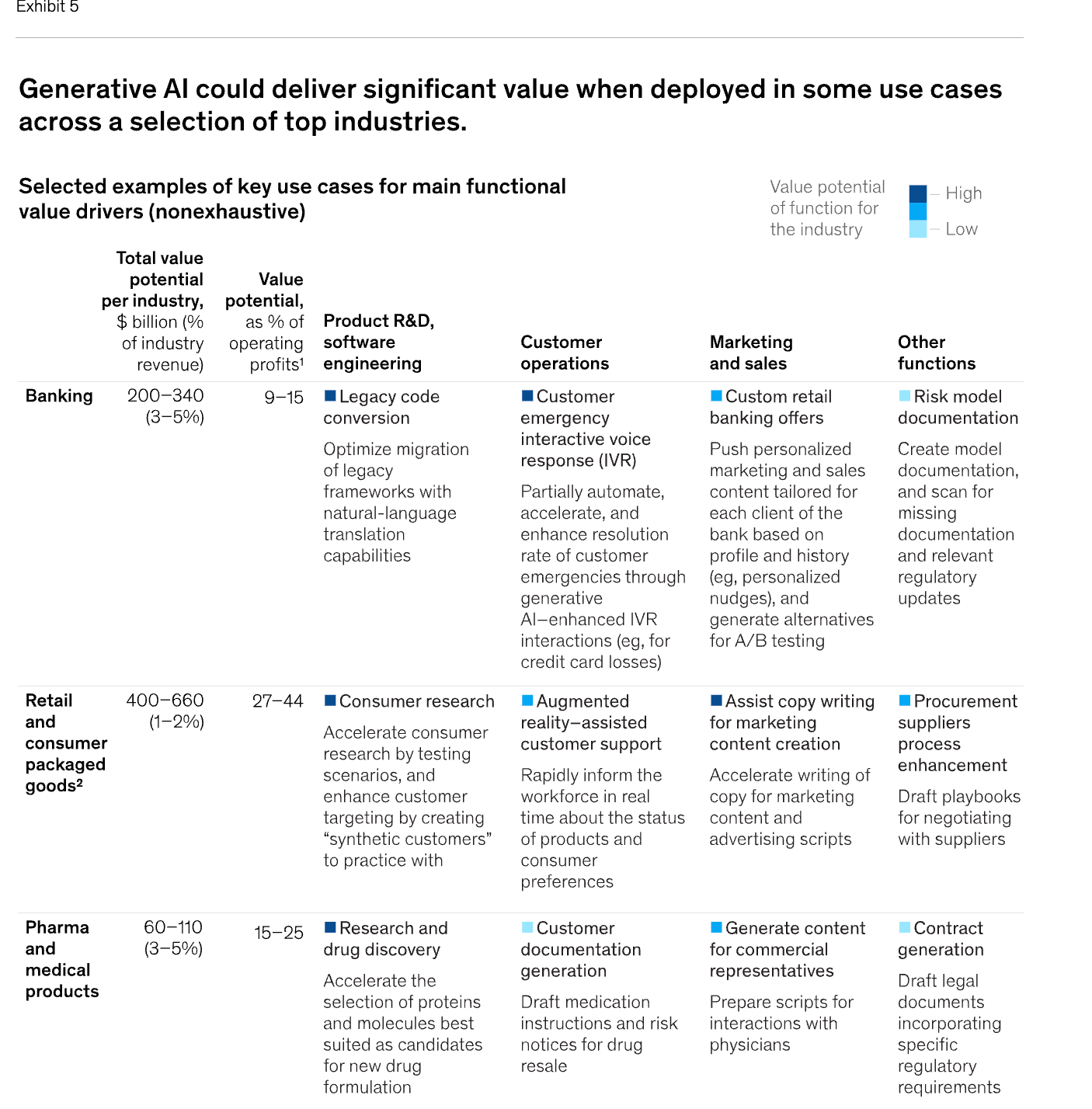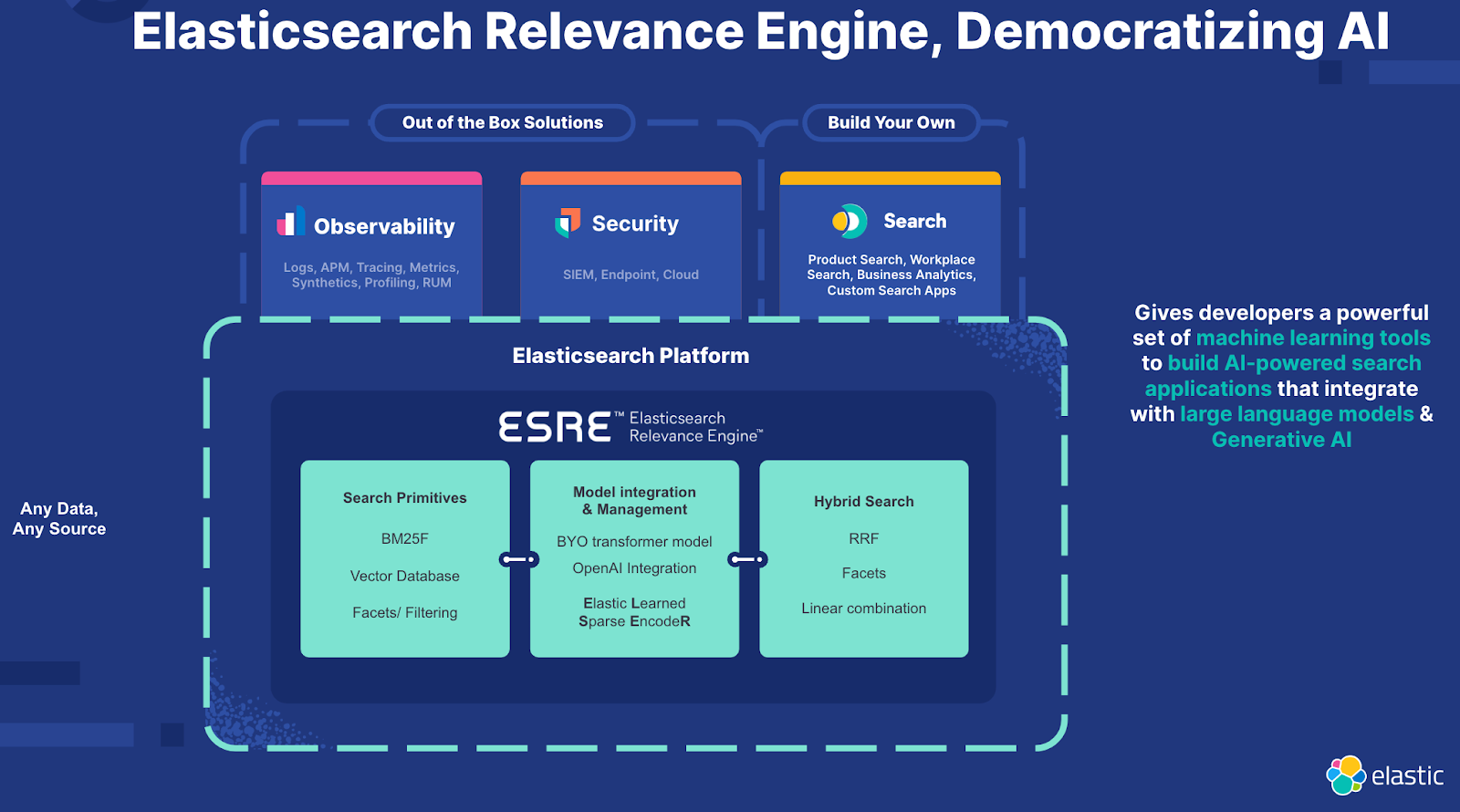The power of generative AI for retail and CPG

The retail and consumer packaged goods (CPG) industry has undergone significant transformations due to advancements in technology. Technological innovations have reshaped various aspects of the industry, including customer engagement, inventory optimization, and supply chain management. These innovations have helped drive digital transformation, improve operational efficiency, enhance the customer experience, and promote sustainability. Retailers and CPG companies that embrace and leverage technology effectively are better positioned to thrive in an increasingly competitive and rapidly evolving market. And as we are all well aware, generative AI is poised to usher in a new era of enhanced productivity. The retail & CPG industry, being no stranger to reaping such benefits, stands to gain significantly from its adoption.
According to a recent report from McKinsey,* 63 use cases for generative AI have been identified across 16 business functions. These use cases have the potential to generate economic benefits ranging from US$2.6 trillion to US$4.4 trillion annually when implemented across various industries. Furthermore, per analysis by McKinsey, generative AI could have an impact on most business functions; however, a few stand out when measured by the technology’s impact as a share of functional cost (Exhibit 3). Out of the 16 business functions identified, four functions — customer operations, marketing and sales, software engineering, and research and development — account for approximately 75% of the total annual value from generative AI use cases.

By leveraging the power of generative AI, companies can gain a competitive edge, meet changing consumer demands, and stay ahead in an increasingly digital and data-driven marketplace. In the retail & CPG industry, per McKinsey estimates, generative AI could contribute roughly US$310 billion in additional value by boosting performance in functions such as marketing and customer interactions. The bulk of potential value in high tech comes from generative AI’s ability to increase the speed and efficiency of software development (Exhibit 5).

To successfully adapt to this transformation, it is vital to tap into the knowledge and capabilities of organizations leading the way in this technological advancement, utilizing their expertise to harness the full potential of Gen AI. One such organization is Elastic®. After I joined Elastic, one of the things that I really enjoy doing is coding and developing tools using Elastic. I am so excited to see how different industries can leverage Elasticsearch® to unlock value using the immense potential of generative AI.
Shift in customer interaction paradigm
Retailers are presented with a big opportunity to differentiate themselves by creating applications that provide customers with a next-generation experience, thereby gaining a competitive advantage. We have entered into an era wherein users interact with a natural language processing (NLP) interface to aid them in product selection. Generative AI can significantly improve the process of product discovery and ordering, elevating the overall shopping experience. There is also a huge opportunity to elevate customer value by delivering personalized experiences that leverage chatbots to emulate human-like conversations about products in ways that can increase customer satisfaction, traffic, and brand loyalty.
NLP enables chatbots to process the user's language, identifies the intent behind their message, and extracts relevant information from it. For example, the goal of NLP is to enable algorithms to process human language and perform tasks that historically only humans were capable of, such as finding relevant passages among large amounts of text, summarizing text, and generating new, original content. These advanced NLP capabilities are built upon a technology known as vector search. Elastic has native support for vector search, performing exact and approximate k-nearest neighbor (kNN) search, and for NLP, enabling the use of custom or third-party models directly in Elasticsearch.
Another significant opportunity for the retail industry to deliver a personalized shopping experience through generative AI is the utilization of visual search. Image similarity search technology, also known as reverse image search, empowers customers to find products effortlessly by uploading or capturing an image. By leveraging generative AI algorithms, retailers can improve the accuracy and relevance of visual search results. This allows customers to easily find similar products, accessories, or even visually complementary items, facilitating a more seamless and personalized shopping experience.
Imagine a customer visiting your site, and they are able to mimic a celebrity’s look with just a screenshot. This experience helps create a highly intuitive search experience for customers, where they can effortlessly find what they are looking for with just an image.
Vector search leverages machine learning (ML) to capture the meaning and context of unstructured data. Vector search finds similar data using approximate nearing neighbor (ANN) algorithms. Compared to traditional text search (in Elastic, based on BM25 scoring), vector search yields more relevant results and executes faster (without the need for extreme search engine optimizations). This approach works not only with text data but also images and other types of unstructured data for which generic embedding models are available. In the case of text data, it is commonly referred to as semantic search, while similarity search is often used in the context of images and audio.

Mitigating the business risks of generative AI
While the enthusiasm surrounding this technology is tangible, it also carries inherent risks. Business leaders face the challenge of identifying the necessary skills and capabilities for their workforce and rethinking core business processes like retraining and skill development. Additionally, they must address a variety of potential security vulnerabilities and privacy risks.
Elastic’s launch of Elasticsearch Relevance Engine™ (ESRE™) helps solve many of the challenges mentioned above. ESRE offers new capabilities for creating highly relevant AI search applications and combines the best of AI with Elastic’s text search to make generative AI search engines. ESRE gives developers a full suite of sophisticated retrieval algorithms and the ability to integrate with large language models (LLMs). Even better, it’s accessible via a simple, unified API that Elastic’s community already trusts, so developers around the world can start using it immediately to elevate search relevance. ESRE also lets developers manage and use their own transformer models in Elastic for business specific context and also bring in third-party transformer models such as OpenAI’s GPT-3 and GPT-4 via API to retrieve intuitive summarization of content based on the customer’s data stores consolidated within Elasticsearch deployments.
Ensuring data privacy is a key consideration for enterprises when securely transmitting proprietary data across networks and components, particularly in the context of developing innovative search experiences. Elastic includes native support for role-based and attribute-based access control to ensure that only those roles with access to data can see it. By leveraging Elasticsearch, your organization can effectively meet the requirement of granting access to privileged individuals for specific documents. This ensures that your organization maintains comprehensive privacy and access controls across all its search applications. Ensuring the highest level of privacy is crucial, making it imperative to keep all data within your organization's network. This not only becomes a top priority but also an obligation. ESRE offers the necessary tools to support your organization in implementing deployments within an air-gapped environment and facilitating secure network access, enabling you to safeguard your data effectively.

Stay up to date on all things generative AI
With the myriad possibilities illuminated by generative AI, Elastic can significantly enhance the speed and efficiency of your adoption in this new era, allowing you to fully capitalize on and leverage the associated benefits. Stay informed on all things related to AI by signing up to receive exclusive news, Elastic product updates, AI trends, hands-on demos, and more!
Additional resources:
- ChatGPT and Elasticsearch: OpenAI meets private data
- Enhancing chatbot capabilities with NLP and vector search in Elasticsearch
- Overview of image similarity search in Elasticsearch
- Elastic introduces Elastic AI Assistant
- Introducing Elasticsearch Relevance Engine™ — Advanced search for the AI revolution
- 5 technical components of image similarity search
- How to deploy natural language processing (NLP): Getting started
- Monitor OpenAI API and GPT models with OpenTelemetry and Elastic
The release and timing of any features or functionality described in this post remain at Elastic's sole discretion. Any features or functionality not currently available may not be delivered on time or at all.
In this blog post, we may have used third party generative AI tools, which are owned and operated by their respective owners. Elastic does not have any control over the third party tools and we have no responsibility or liability for their content, operation or use, nor for any loss or damage that may arise from your use of such tools. Please exercise caution when using AI tools with personal, sensitive or confidential information. Any data you submit may be used for AI training or other purposes. There is no guarantee that information you provide will be kept secure or confidential. You should familiarize yourself with the privacy practices and terms of use of any generative AI tools prior to use.
Elastic, Elasticsearch and associated marks are trademarks, logos or registered trademarks of Elasticsearch N.V. in the United States and other countries. All other company and product names are trademarks, logos or registered trademarks of their respective owners.

